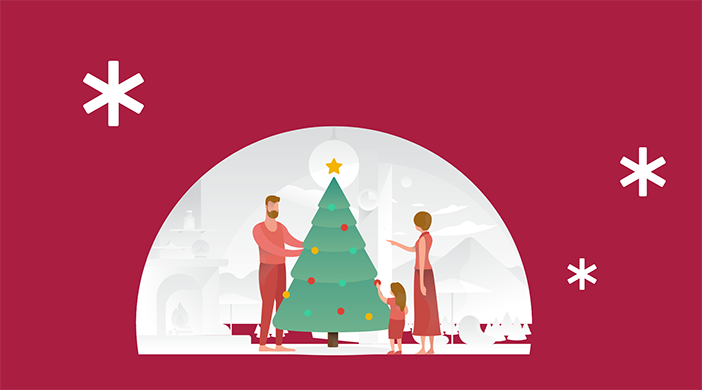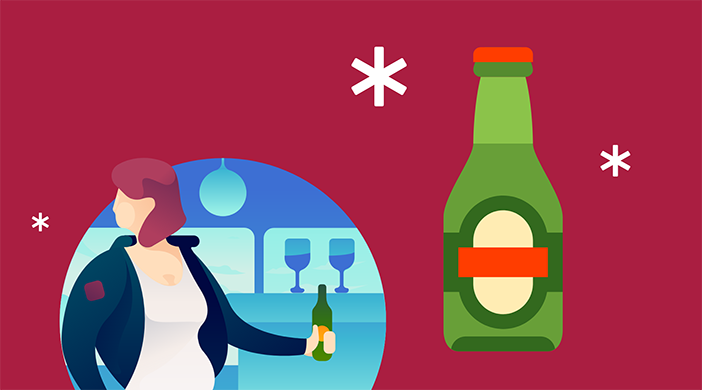
First of all, let’s establish when it’s Christmas in Denmark. The main Christmas days go from the day before Christmas Eve on 23 December until Boxing Day on 26 December.
In Denmark, our biggest celebration of Christmas is on 24 December. This is when we traditionally celebrate juleaften (Christmas Eve) with Christmas dinner and presents. Many take time off from 24 December until 26 December. A lot of families with children also take a holiday between Christmas and New Year when schools are closed.
By the way, did you know that Christmas started as a ’feast of the Vikings’?
Christmas is the most celebrated holiday in Denmark. We know Christmas as a Christian festival, but that hasn’t always been the case. As late as the 1100s, Christmas in Denmark wasn’t Christian at all. The word jul comes from the old word ‘yul’ which means ‘feast’. (Perhaps you know the English word ‘Yuletide’. It’s the same word.) For centuries, it has been popular to have a feast around the winter solstice. This is the darkest time of year – the time when it starts to get lighter again and the days slowly get longer in Denmark.
The winter solstice was celebrated by lighting fires, drinking alcohol and eating a lot of food. However, the Christian Church wanted jul to be a peaceful celebration of the birth of Jesus. The Christian Church succeeded in influencing the old Nordic Viking culture – although not in all aspects. That’s why Danish Christmas is as we know it today – a cultural and religious mix of traditions and customs that have taken shape through history.
But enough about the history of Christmas. Now for the 15 useful words you must know.

1 Did you know that we dance around JULETRÆET (the Christmas tree) in Denmark?
In Denmark, we have a special tradition with our juletræ (Christmas tree): We dance around the tree on 24 December, Christmas Eve. Or rather, we call it ‘dancing’. In reality, it isn’t so much of a dance. It simply means that we walk around the Christmas tree holding hands as we sing. Some sing Christian hymns such as ’Et barn er født i Betlehem’, while others prefer Christmas songs that aren’t religious, such as ’På loftet sidder nissen med sin julegrød’. We decorate the tree with garlands, paper hearts (’julehjerter’) and often also with Danish flags and candles. We put the presents under the tree and open them late on Christmas eve, once the family has eaten and danced around the tree. It’s tough for children to wait so long while looking at the tempting gifts.
2 PEBERNØDDER are the smallest biscuits with the most powerful flavour
These biscuits (literally called ‘pepper nuts’) are the size of a hazelnut. They’re generously spiced with cardamom, cinnamon, nutmeg, cloves and of course pepper. And we can assure anyone with allergies that there aren’t actually any nuts in pebernødder. They’re simply the size of a nut. You will definitely get to taste pebernødder if you spend December in Denmark. Many places put out a bowl of them as a snack, for instance at a reception desk or a shop counter. Pebernødder are some of the oldest cakes that have been baked in Denmark. In the old days, they were made with leftover dough from making bread. People simply added spices and honey to that dough. Then they rolled the dough into a long ‘sausage’ and cut it into small pieces that could then be rolled into small round biscuits. You can find a modern and good recipe for pebernødder here (in Danish).

3 We use JULEKALENDEREN (the Advent calendar) to count the days until 24 December
For many Danes, Christmas really starts on 1 December when they start opening their julekalender (Advent calendar). Julekalenderen in Denmark is many things. It can be a calendar made of cardboard with 24 doors. Every day in December, you open one door. Behind each door is a surprise, it can be a piece of chocolate or a toy. A julekalender can also be a TV series with 24 episodes, one for each day in December leading up to Christmas. Many children have a pakkekalender (‘present calendar’) consisting of 24 little gifts that patient parents or grandparents have wrapped for the child – one for every morning in December. And there is also kalenderlyset (the Advent candle): A candle with the numbers from 1 to 24 printed on its side. Every day in December, you light the Advent candle and burn it a bit and on Christmas Eve, you burn the number 24.
4 Get excited for your first JULEFROKOST (Christmas lunch)
A julefrokost is a celebration in December that features Christmas food and often a considerable amount of alcohol. Many workplaces arrange a julefrokost for their employees. A julefrokost often starts in the middle of the day and continues until late in the evening or the early hours of the morning. Many families have a julefrokost on Christmas Day or the day after. Danes often say that they ’accidentally’ ate or drank too much at the julefrokost. Perhaps a leftover from the old Nordic solstice feasts?
5 SNAPS is not the same as akvavit
Snaps is a type of distilled wine with a high concentration of alcohol, usually between 30% and 45%. It can have flavourings of fruits, spices or herbs. Many Danes think that akvavit and snaps are the same thing. But there is a difference. Akvavit is a protected name that may only be used for distilled wine with dill and/or cumin and at least 37,5% alcohol. At a julefrokost, you might be served snaps or akvavit. It is usually served in tiny little glasses. Some Danes hold on to a tradition of emptying their glass in one mouthful. But be careful! Experts recommend sipping the snaps slowly. That way, you can better enjoy the nuances of the flavours. And you can control the effect of the alcohol better, too.

6 NISSER look cute – but they can be full of mischief!
A nisse is a supernatural being from old folk tales. There are many different explanations of what a nisse is. If you see little dolls with pointy red hats in shops, know that those are supposed to be nisser. In the old days, it was believed that nisser could help people – or ‘drille’ (make mischief for) them! In Danish we have this expression: ’Nissen flytter med’ (the nisse moves with you). It means that your problems often stay the same, even though you might change your surroundings, job or partner. In some workplaces, people pretend to be nisser in the month of December. This is the Danish version of Secret Santa. It means that each person in a workplace is given a secret nisse friend, i.e. a colleague that you then get to spoil – or play mild tricks on. Usually by arranging small surprises and gifts. The last day before Christmas, the identity of all nisse friends is revealed. But you have to guess first.
7 JULEGUDSTJENESTE: During Christmas, more Danes go to church
Usually, there is a connection between believing in God and going to church. But Christmas is different. Many Danes go to church on 24 December to enjoy the festive, solemn atmosphere. They also go to church to meet people they know and wish them a merry Christmas. So even though fewer Danes believe in God, more people go to church on Christmas Eve. Some believe it’s because the church offers an alternative to the more commercial aspects of Christmas. Julegudstjenesten (the Christmas service) takes place on 24 December. But there are also many that go to church on første and anden juledag, 25 and 26 December. There are also many Danish school classes that attend a church service during the month of December. That might surprise you if you are used to church and state being clearly separated in your home country.
8 You simply have to try ÆBLESKIVER
Æbleskiver (literally ’apple slices’) usually don’t contain any apple. These little dough balls are the size of a lime and cooked in a frying pan with half-sphere molds. You serve the æbleskiver warm with sugar and jam as topping. So why are they called æbleskiver? Well, in the old days, æbleskiver were made by dipping a slice of apple in dough and frying it. Around the beginning of the 1700s, people started making æbleskiver like we know them today. If you spend December in Denmark and visit a Christmas market, you can try ordering warm æbleskiver. They are extra delicious when enjoyed outside in the cold December weather.
9 If you’re cold, you can always warm up with a glass of GLÖGG (mulled wine)
Glögg (Danish-style mulled wine) is a warm Christmas drink served outside as well as indoors during the cold winter months. Glögg can have different ingredients. Some of the most typical are: Red wine, perhaps rum, raisins, almonds and of course the classic Christmas spices cinnamon and cloves. It is said that glögg has its roots in ancient Rome, where people warmed up distilled wine using glowing coals. But Germany too has a history of drinking glögg in the splendid castles along the Rhine that goes back to the 1400s. In Denmark, glögg is a relatively recent tradition. Danes didn’t start drinking glögg until the 1900s. It was not the Germans, but rather Swedish tradespeople who were successful in introducing glögg to the Danish market. They promoted the product with small pictures of nisser on the bottles, something that Danes could not resist.

10 At its root, JULEBRYG is a commercial invention
Julebryg (’Christmas brew’) is a special beer that breweries send into shops in the time leading up to Christmas. It has a higher alcohol concentration than regular lager, so you might be surprised! (Julebryg is not the same as nisseøl, a low-alcohol Christmas beer with a sweet taste). In 1990, the brewery Tuborg introduced the concept of ‘J-dag’ (‘J-Day’) in the promotion of Tuborg Julebryg. J-Day was advertised as the day in November when Tuborg sent its Julebryg into shops and bars. And it was a success. Since then, J-Day has become kind of a Christmas tradition. It’s the day when bars and pubs celebrate the release of Tuborg Julebryg and friends meet up to drink one or maybe two.
11 From fancy delicacy to simple everyday dish: Read about the history of RISENGRØD
Risengrød (literally ’rice porridge’) is what the name describes. It’s a porridge with rice boiled in milk and a little salt added. It’s served with a knob of butter and cinnamon sugar. In the 1800s, people in Denmark also ate risengrød. Back then, rice was an expensive imported good, making risengrød an exclusive dish that only the bourgeoisie could afford. But in the 1900s, rice became a more and more common sight at the grocer’s, and risengrød became a common dish that everyone could afford. Risengrød was no longer a status symbol. So people tried to develop the risengrød by mixing it with chopped almonds, cream and vanilla. This became risalamande, the dessert that most Danes eat on Christmas Eve. However, risengrød is still popular – especially among children. Many Danes cook risengrød and eat it as a snack or dinner during December. Some even leave out a bowl of risengrød for their nisse in the hopes this will stop him from making mischief!

12 Who will get the MANDELGAVE this year?
In Denmark, we have a tradition where we put a whole, blanched (‘smuttet’) almond in our risalamande. It’s easily hidden in the white dessert so that no one can see who gets the portion with the almond. Mandelgaven (’the almond present’) is a present for the person who discovers the entire almond in their risalamande. (Or risengrød.) In the old days, the mandelgave was usually a marzipan pig. After all, you don’t know ahead of time who will get the almond. It could be an adult or a child, and it’s best that the present suits both.
13 Most people eat pork on Christmas Eve. Have you ever tried FLÆSKESTEG (roast pork)?
Flæskesteg is a traditional Danish pork dish that is served at julefrokoster and on Christmas Eve. The crackling is a delicacy that is hard to prepare because it should be extra crispy. (Pork crackling is also eaten as a snack!) A flæskesteg can be prepared in many different ways, and most families have their own traditions. About 60% of Danes eat flæskesteg for Christmas. And many eat a roast duck too, now that they’re at it!

14 Did you know that RØDKÅLEN (the red cabbage) was ’designed’ to match the Danish flag?
Rødkål (red cabbage) is a classic trimming that goes with the flæskesteg that is served for Christmas dinner in most Danish homes. Rødkålen is thinly sliced, sautéed and then boiled with apple vinegar, cloves and sugar. Danes have eaten rødkål since the end of the 1800s. Back then, the national sentiment was so strong that Christmas dinner was adjusted to look like the Danish flag with red and white colours. That’s why green cabbage was replaced with the red one which was then served with white potatoes for the perfect colour combination. Traditionally, rødkål had a sweet and sour taste. But in the 1990s, Danes started to experiment with exotic spices. Don’t be surprised if a Dane serves you rødkål that has been seasoned with all spice and cinnamon.
15 Of course potatoes taste better with sugar! Try BRUNEDE KARTOFLER
Brunede kartofler (’browned potatoes’) are another classic trimming with Christmas dinner. They are boiled potatoes that have been caramelised in a sugary brine. That’s what makes them brown. It’s easy to mess up brunede kartofler, because the sugar needs to melt at the exact right temperature. Otherwise it gets lumpy or chars. Ready-made brunede kartofler can be a solution for those that get easily stressed in the kitchen on 24 December. Danes have been eating brunede kartofler since the 1800s. The dish originated as a cheaper alternative to candied chestnuts. It wasn’t all that cheap, though. Sugar was an expensive imported good in Denmark until we finally started our own production of sugar beets in the 1890s. (That also means that the tradition of eating a lot of sweets around Christmas didn’t exist until the 1900s.) Most Danes serve brunede kartofler as well as plain white potatoes with Christmas dinner. Velbekomme (enjoy!).








